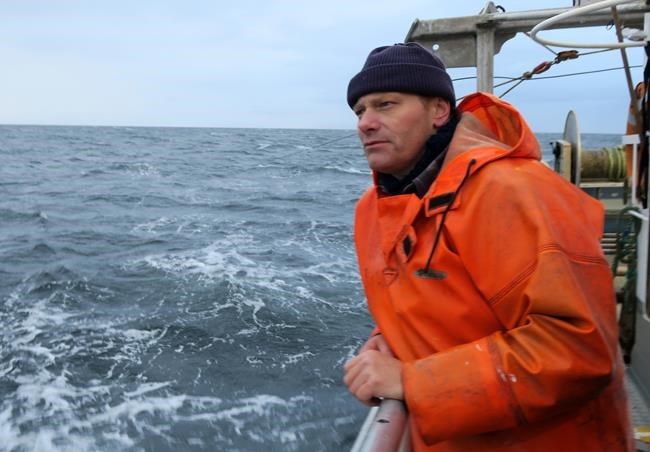Jan M. Olsen

In this Thursday, Oct. 6, 2016 photo, Ulrik Koelle Hansen looks out from the fishing boat in the western part of the Baltic Sea. Ahead of next week’s European Union meeting on whether to slash the fishing quota for dwindling cod stock in the western Baltic Sea, coastal fishermen fear they may have to go trawling elsewhere. (AP Photo/ Jan M. Olsen)
October 10, 2016 - 3:52 PM
BAGENKOP, Denmark - A stiff wind buffets Ulrik Koelle Hansen's trawler as he heads out of this tiny fishing village in search of an early morning catch, but it's nothing to the battering he predicts if the European Union slashes the fishing quota for cod in the western Baltic, as it did late Monday.
According to scientists and environmentalists, the region's cod stock is on the verge of collapse. While scientists are pushing for the quota to be cut by about 90 per cent, conservation groups want to shut it down temporarily.
"If we do not do something in time to allow the cod to recover, it may mean that we lose the (cod) fishery altogether in the near future," said Inger Melander, a spokeswoman for the Swedish branch of the World Wildlife Fund.
After all-day negotiations in Luxembourg, the European Union late Monday agreed to set tougher cod catch quotas, but stayed well above targets sought by scientists and environmentalists. The EU fisheries ministers agreed on a 56 per cent quota cut for the western Baltic cod caught off Denmark and Germany.
Officials said Denmark pushed hard to safeguard the livelihood of its fishermen to make sure there was enough that they would still be allowed to catch.
As Koelle Hansen sees it, cutting the quota would mean the end for the few fisherman still working out of Bagenkop, a sleepy fishing village of less than 500 people on the southern tip of the Langeland island.
"It's a total disaster if they cut the quota. That means that the five boats that are left, will disappear for good," said Koelle Hansen, a 46-year-old Dane who started fishing at age 14.
"I bought this tiny trawler a few years ago because we were told that we would only be allowed to fish with them. Now we may have to sell it and relocate," he said. "These trawlers cannot damage the stock. This isn't an industrial vessel that shovels up everything."
For decades, Danish, Swedish, Polish and German fishermen have worked the sea south of Denmark and north of Germany. Roughly one-third of Denmark's total cod catches come from the western Baltic. Last year, cod brought to land totalled 22,818 tons — out of which 6,807 tons came from the region.
In 2014, 1,112 tons of western cod was landed in Bagenkop, once a bustling fishing harbour with some 70 trawlers and a dozen smaller vessels.
But successive quota reductions have sent Bagenkop downhill. Once a couple of hundred people were employed by the fish industry. Today there are 20-30 and fewer than 10 boats — both trawlers and other fishing vessels — left, said Steffen Rasmussen, chairman of a local fishery history society.
"I am damn nervous," said Koelle Hansen, who fishes for a few hours several times a week from his trawler Cecilie, a 13.5-meter (44.6-feet) wooden ship. "It would mean I'd have to sell this vessel and go catching (Norwegian) lobster in the North Sea instead" — aboard a larger industrial vessel.
The EU has agreed to revamp its fishing policies to protect dozens of species from commercial extinction, and by 2020 all fish must be sustainably caught. Member states, however, have refused to accept scientific advice and have sought the best deal possible for the industry, not for the survival of the fish. EU ministers must make a decision at their two-day meeting in Luxembourg, starting Monday.
Denmark's minister in charge of fisheries, Esben Lunde Larsen, vowed to "fight for a less drastic reduction."
"Our sole ally here is Germany. Virtually all other countries, including Sweden, will reduce the quota for cod in the western area along what the Commission proposes," he said in a statement to The Associated Press.
Germany's Agriculture Ministry refused to comment, saying that it needed to remain neutral ahead of Monday's talks.
During the 1965-1985 period, the western Baltic cod stock yielded catches between 40,000 tons and 50,000 tons per year. But landings have since steadily decreased. Now, the Copenhagen-based International Council for the Exploration of the Sea suggests reducing the Total Allowable Catch for the region's cod from 12,720 tons to 917 tons in 2017.
Under Monday's agreement, the allowable catch for the region's cod will be between 5,000 and 6,000 tons.
Henrike Semmler, a spokeswoman for the ocean conservationist group Oceana, said a temporary total stop "will have severe impact on the small scale fishermen. But continued overfishing means the stock will collapse."
The cod season is over for now, so Koelle Hansen and other fishermen catch flatfish. He says he has not seen a reduction of fish generally in the region. After catching nearly 500 kilograms of flatfish (1,100 pounds), he shouted: "See ... there are plenty of fish out here."
"The scientific advice must be wrong," he said. "(Nature) tells me whether there are cods or not. If the wind blows in a specific direction, I know where to fish."
___
Vitnija Saldava and David Rising in Berlin contributed to this report.
News from © The Associated Press, 2016